Wenwen Yu
OmniParser V2: Structured-Points-of-Thought for Unified Visual Text Parsing and Its Generality to Multimodal Large Language Models
Feb 22, 2025Abstract:Visually-situated text parsing (VsTP) has recently seen notable advancements, driven by the growing demand for automated document understanding and the emergence of large language models capable of processing document-based questions. While various methods have been proposed to tackle the complexities of VsTP, existing solutions often rely on task-specific architectures and objectives for individual tasks. This leads to modal isolation and complex workflows due to the diversified targets and heterogeneous schemas. In this paper, we introduce OmniParser V2, a universal model that unifies VsTP typical tasks, including text spotting, key information extraction, table recognition, and layout analysis, into a unified framework. Central to our approach is the proposed Structured-Points-of-Thought (SPOT) prompting schemas, which improves model performance across diverse scenarios by leveraging a unified encoder-decoder architecture, objective, and input\&output representation. SPOT eliminates the need for task-specific architectures and loss functions, significantly simplifying the processing pipeline. Our extensive evaluations across four tasks on eight different datasets show that OmniParser V2 achieves state-of-the-art or competitive results in VsTP. Additionally, we explore the integration of SPOT within a multimodal large language model structure, further enhancing text localization and recognition capabilities, thereby confirming the generality of SPOT prompting technique. The code is available at \href{https://github.com/AlibabaResearch/AdvancedLiterateMachinery}{AdvancedLiterateMachinery}.
ClickTrack: Towards Real-time Interactive Single Object Tracking
Nov 24, 2024



Abstract:Single object tracking(SOT) relies on precise object bounding box initialization. In this paper, we reconsidered the deficiencies in the current approaches to initializing single object trackers and propose a new paradigm for single object tracking algorithms, ClickTrack, a new paradigm using clicking interaction for real-time scenarios. Moreover, click as an input type inherently lack hierarchical information. To address ambiguity in certain special scenarios, we designed the Guided Click Refiner(GCR), which accepts point and optional textual information as inputs, transforming the point into the bounding box expected by the operator. The bounding box will be used as input of single object trackers. Experiments on LaSOT and GOT-10k benchmarks show that tracker combined with GCR achieves stable performance in real-time interactive scenarios. Furthermore, we explored the integration of GCR into the Segment Anything model(SAM), significantly reducing ambiguity issues when SAM receives point inputs.
Click; Single Object Tracking; Video Object Segmentation; Real-time Interaction
Nov 20, 2024



Abstract:Single object tracking(SOT) relies on precise object bounding box initialization. In this paper, we reconsidered the deficiencies in the current approaches to initializing single object trackers and propose a new paradigm for single object tracking algorithms, ClickTrack, a new paradigm using clicking interaction for real-time scenarios. Moreover, click as an input type inherently lack hierarchical information. To address ambiguity in certain special scenarios, we designed the Guided Click Refiner(GCR), which accepts point and optional textual information as inputs, transforming the point into the bounding box expected by the operator. The bounding box will be used as input of single object trackers. Experiments on LaSOT and GOT-10k benchmarks show that tracker combined with GCR achieves stable performance in real-time interactive scenarios. Furthermore, we explored the integration of GCR into the Segment Anything model(SAM), significantly reducing ambiguity issues when SAM receives point inputs.
OmniParser: A Unified Framework for Text Spotting, Key Information Extraction and Table Recognition
Mar 28, 2024Abstract:Recently, visually-situated text parsing (VsTP) has experienced notable advancements, driven by the increasing demand for automated document understanding and the emergence of Generative Large Language Models (LLMs) capable of processing document-based questions. Various methods have been proposed to address the challenging problem of VsTP. However, due to the diversified targets and heterogeneous schemas, previous works usually design task-specific architectures and objectives for individual tasks, which inadvertently leads to modal isolation and complex workflow. In this paper, we propose a unified paradigm for parsing visually-situated text across diverse scenarios. Specifically, we devise a universal model, called OmniParser, which can simultaneously handle three typical visually-situated text parsing tasks: text spotting, key information extraction, and table recognition. In OmniParser, all tasks share the unified encoder-decoder architecture, the unified objective: point-conditioned text generation, and the unified input & output representation: prompt & structured sequences. Extensive experiments demonstrate that the proposed OmniParser achieves state-of-the-art (SOTA) or highly competitive performances on 7 datasets for the three visually-situated text parsing tasks, despite its unified, concise design. The code is available at https://github.com/AlibabaResearch/AdvancedLiterateMachinery.
P2Seg: Pointly-supervised Segmentation via Mutual Distillation
Jan 18, 2024Abstract:Point-level Supervised Instance Segmentation (PSIS) aims to enhance the applicability and scalability of instance segmentation by utilizing low-cost yet instance-informative annotations. Existing PSIS methods usually rely on positional information to distinguish objects, but predicting precise boundaries remains challenging due to the lack of contour annotations. Nevertheless, weakly supervised semantic segmentation methods are proficient in utilizing intra-class feature consistency to capture the boundary contours of the same semantic regions. In this paper, we design a Mutual Distillation Module (MDM) to leverage the complementary strengths of both instance position and semantic information and achieve accurate instance-level object perception. The MDM consists of Semantic to Instance (S2I) and Instance to Semantic (I2S). S2I is guided by the precise boundaries of semantic regions to learn the association between annotated points and instance contours. I2S leverages discriminative relationships between instances to facilitate the differentiation of various objects within the semantic map. Extensive experiments substantiate the efficacy of MDM in fostering the synergy between instance and semantic information, consequently improving the quality of instance-level object representations. Our method achieves 55.7 mAP$_{50}$ and 17.6 mAP on the PASCAL VOC and MS COCO datasets, significantly outperforming recent PSIS methods and several box-supervised instance segmentation competitors.
P2RBox: A Single Point is All You Need for Oriented Object Detection
Nov 22, 2023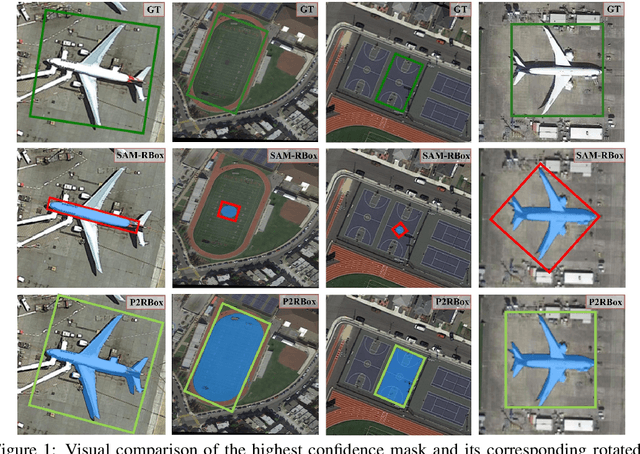
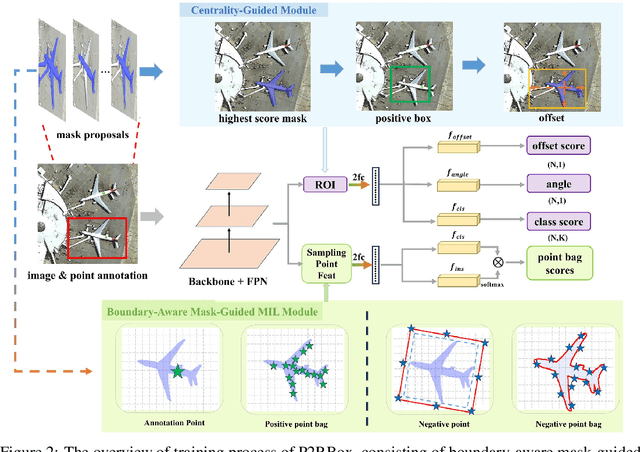
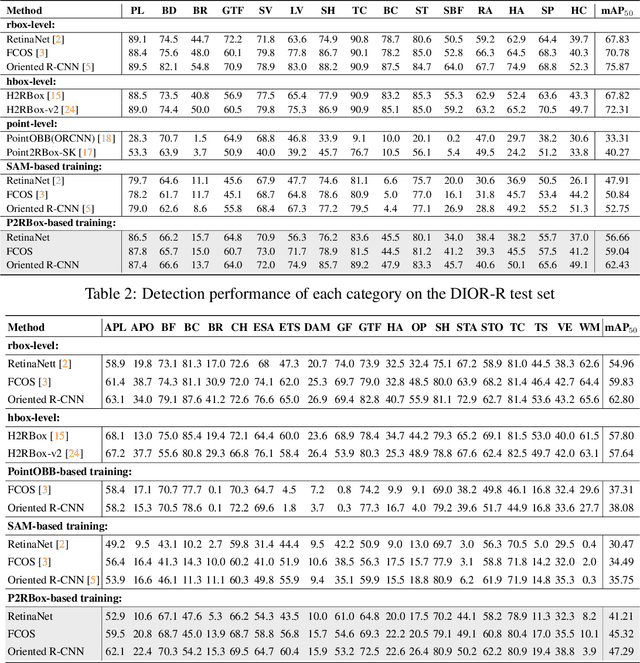
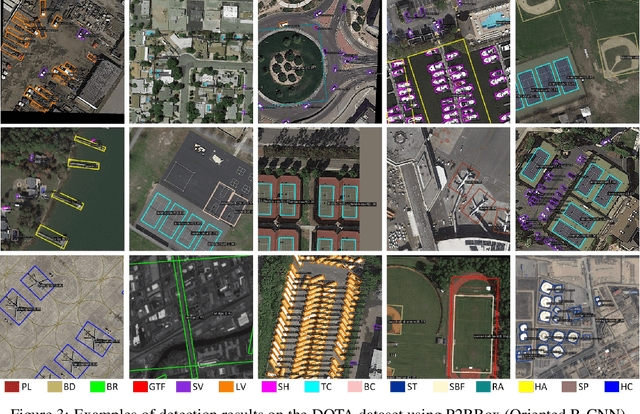
Abstract:Oriented object detection, a specialized subfield in computer vision, finds applications across diverse scenarios, excelling particularly when dealing with objects of arbitrary orientations. Conversely, point annotation, which treats objects as single points, offers a cost-effective alternative to rotated and horizontal bounding boxes but sacrifices performance due to the loss of size and orientation information. In this study, we introduce the P2RBox network, which leverages point annotations and a mask generator to create mask proposals, followed by filtration through our Inspector Module and Constrainer Module. This process selects high-quality masks, which are subsequently converted into rotated box annotations for training a fully supervised detector. Specifically, we've thoughtfully crafted an Inspector Module rooted in multi-instance learning principles to evaluate the semantic score of masks. We've also proposed a more robust mask quality assessment in conjunction with the Constrainer Module. Furthermore, we've introduced a Symmetry Axis Estimation (SAE) Module inspired by the spectral theorem for symmetric matrices to transform the top-performing mask proposal into rotated bounding boxes. P2RBox performs well with three fully supervised rotated object detectors: RetinaNet, Rotated FCOS, and Oriented R-CNN. By combining with Oriented R-CNN, P2RBox achieves 62.26% on DOTA-v1.0 test dataset. As far as we know, this is the first attempt at training an oriented object detector with point supervision.
Turning a CLIP Model into a Scene Text Spotter
Aug 21, 2023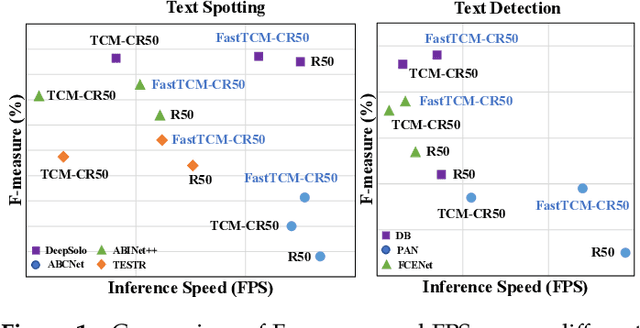
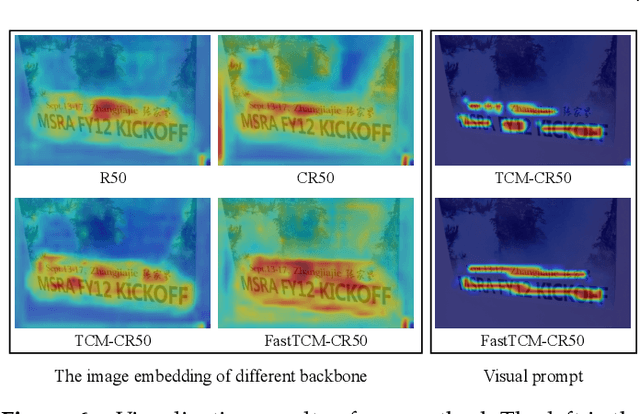
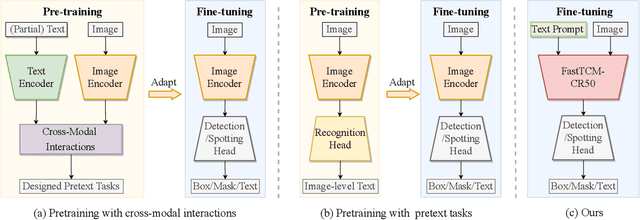
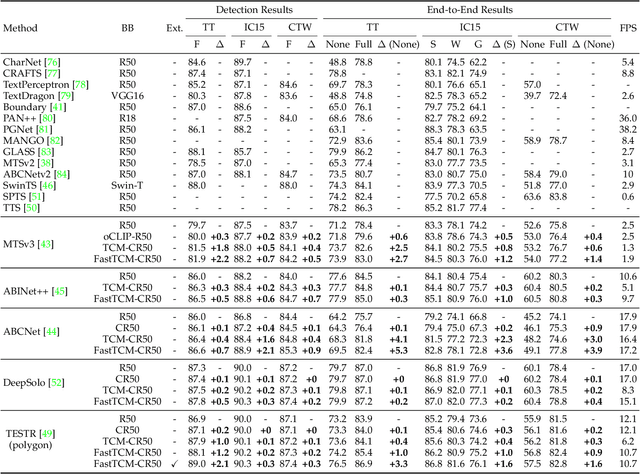
Abstract:We exploit the potential of the large-scale Contrastive Language-Image Pretraining (CLIP) model to enhance scene text detection and spotting tasks, transforming it into a robust backbone, FastTCM-CR50. This backbone utilizes visual prompt learning and cross-attention in CLIP to extract image and text-based prior knowledge. Using predefined and learnable prompts, FastTCM-CR50 introduces an instance-language matching process to enhance the synergy between image and text embeddings, thereby refining text regions. Our Bimodal Similarity Matching (BSM) module facilitates dynamic language prompt generation, enabling offline computations and improving performance. FastTCM-CR50 offers several advantages: 1) It can enhance existing text detectors and spotters, improving performance by an average of 1.7% and 1.5%, respectively. 2) It outperforms the previous TCM-CR50 backbone, yielding an average improvement of 0.2% and 0.56% in text detection and spotting tasks, along with a 48.5% increase in inference speed. 3) It showcases robust few-shot training capabilities. Utilizing only 10% of the supervised data, FastTCM-CR50 improves performance by an average of 26.5% and 5.5% for text detection and spotting tasks, respectively. 4) It consistently enhances performance on out-of-distribution text detection and spotting datasets, particularly the NightTime-ArT subset from ICDAR2019-ArT and the DOTA dataset for oriented object detection. The code is available at https://github.com/wenwenyu/TCM.
Looking and Listening: Audio Guided Text Recognition
Jun 06, 2023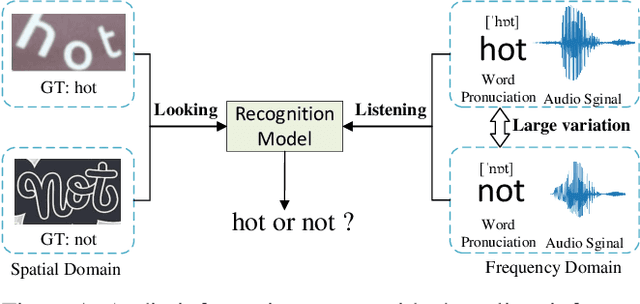
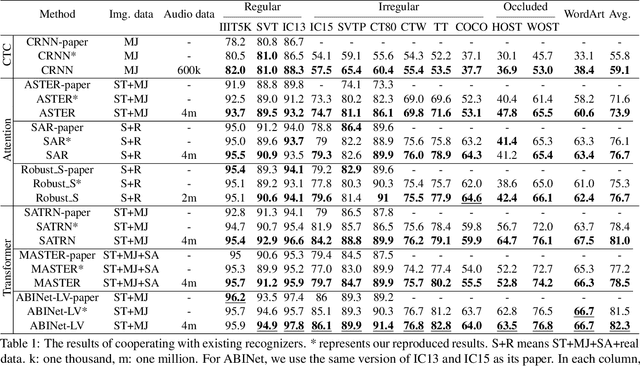
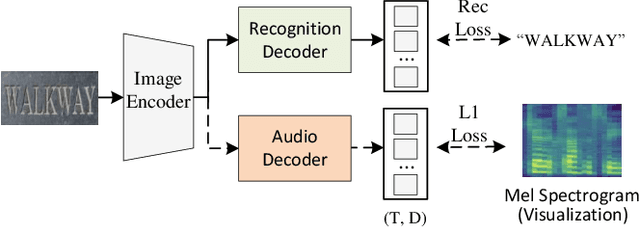
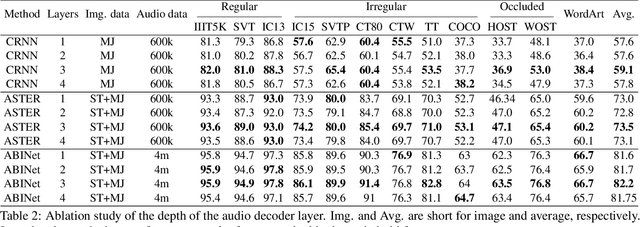
Abstract:Text recognition in the wild is a long-standing problem in computer vision. Driven by end-to-end deep learning, recent studies suggest vision and language processing are effective for scene text recognition. Yet, solving edit errors such as add, delete, or replace is still the main challenge for existing approaches. In fact, the content of the text and its audio are naturally corresponding to each other, i.e., a single character error may result in a clear different pronunciation. In this paper, we propose the AudioOCR, a simple yet effective probabilistic audio decoder for mel spectrogram sequence prediction to guide the scene text recognition, which only participates in the training phase and brings no extra cost during the inference stage. The underlying principle of AudioOCR can be easily applied to the existing approaches. Experiments using 7 previous scene text recognition methods on 12 existing regular, irregular, and occluded benchmarks demonstrate our proposed method can bring consistent improvement. More importantly, through our experimentation, we show that AudioOCR possesses a generalizability that extends to more challenging scenarios, including recognizing non-English text, out-of-vocabulary words, and text with various accents. Code will be available at https://github.com/wenwenyu/AudioOCR.
ICDAR 2023 Competition on Structured Text Extraction from Visually-Rich Document Images
Jun 05, 2023Abstract:Structured text extraction is one of the most valuable and challenging application directions in the field of Document AI. However, the scenarios of past benchmarks are limited, and the corresponding evaluation protocols usually focus on the submodules of the structured text extraction scheme. In order to eliminate these problems, we organized the ICDAR 2023 competition on Structured text extraction from Visually-Rich Document images (SVRD). We set up two tracks for SVRD including Track 1: HUST-CELL and Track 2: Baidu-FEST, where HUST-CELL aims to evaluate the end-to-end performance of Complex Entity Linking and Labeling, and Baidu-FEST focuses on evaluating the performance and generalization of Zero-shot / Few-shot Structured Text extraction from an end-to-end perspective. Compared to the current document benchmarks, our two tracks of competition benchmark enriches the scenarios greatly and contains more than 50 types of visually-rich document images (mainly from the actual enterprise applications). The competition opened on 30th December, 2022 and closed on 24th March, 2023. There are 35 participants and 91 valid submissions received for Track 1, and 15 participants and 26 valid submissions received for Track 2. In this report we will presents the motivation, competition datasets, task definition, evaluation protocol, and submission summaries. According to the performance of the submissions, we believe there is still a large gap on the expected information extraction performance for complex and zero-shot scenarios. It is hoped that this competition will attract many researchers in the field of CV and NLP, and bring some new thoughts to the field of Document AI.
On the Hidden Mystery of OCR in Large Multimodal Models
May 13, 2023Abstract:Large models have recently played a dominant role in natural language processing and multimodal vision-language learning. It remains less explored about their efficacy in text-related visual tasks. We conducted a comprehensive study of existing publicly available multimodal models, evaluating their performance in text recognition, text-based visual question answering, and key information extraction. Our findings reveal strengths and weaknesses in these models, which primarily rely on semantic understanding for word recognition and exhibit inferior perception of individual character shapes. They also display indifference towards text length and have limited capabilities in detecting fine-grained features in images. Consequently, these results demonstrate that even the current most powerful large multimodal models cannot match domain-specific methods in traditional text tasks and face greater challenges in more complex tasks. Most importantly, the baseline results showcased in this study could provide a foundational framework for the conception and assessment of innovative strategies targeted at enhancing zero-shot multimodal techniques. Evaluation pipeline will be available at https://github.com/Yuliang-Liu/MultimodalOCR.
 Add to Chrome
Add to Chrome Add to Firefox
Add to Firefox Add to Edge
Add to Edge